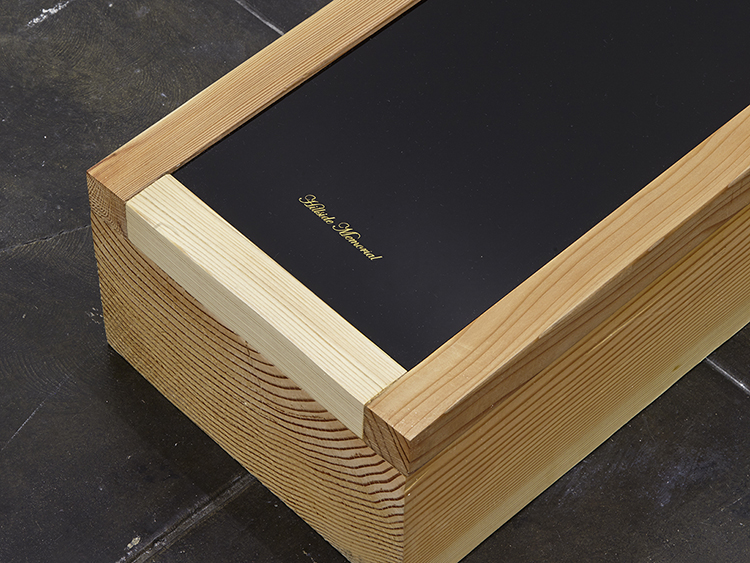
In the Spirit of Summer Memories
by Alicia Eler on August 22, 2014
LOS ANGELES — The summer months are a time of slowing down, going out, hitting the beach, and drinking far too many iced coffee beverages. And yes, I even remember you., a five-person group show at Aran Cravey Gallery curated by Eric Kim, wraps up the summer season nicely, reminding visitors of the slippery line between personal stories and broader histories. Are there dominant cultural narratives today, or do we each create and reinforce our own through personal experiences and filter bubbles?
Scott Benzel’s large-scale sculpture dominates the front of the gallery, greeting viewers upon entrance like a beefy bouncer at a club. In “Magnified/Erased” (2014), Benzel revisits American musician Neil Young’s nostril as seen in The Last Waltz (1978), a documentary made by Martin Scorsese about The Band’s last concert. It’s now a well-documented fact that when Young came onstage to sing “Helpless,” he forgot to clean up the traces of his pre-performance coke habits. Later, Scorsese had to pay big bucks to clean up the screen version of Young’s nose, joking that it was “the most expensive cocaine I’ve ever bought.” In Benzel’s piece, he slows down and zooms in on Young’s nose in the film; behind the video loop hangs a blown-up photograph of a flake of cocaine. Two American legends up-close and personal — drugs and rock stars — reveal that living on stardust isn’t sustainable or pretty. Here we see the cloak of fame overturned; no one can maintain appearances forever — not even pop itself.
Benzel adds to this theme of spiritual deficiencies with “L’Affaire de La Chasse spirituelle” (2014), a collection of “stolen” books. One of them, Famous All Over Town, a story about a Mexican- American guy growing up in LA, was written by author Daniel Lewis James but published under the pseudonym Danny Santiago. The Latino name led readers to interpret the book as partial autobiography, but the truth is that Santiago is really James, a white man who wrote as a Chicano. How much does that knowledge affect our reading of the text? It’s up to each individual to decide. A woman named Dania Sanchez, reviewing All Over Town on Amazon, wrote: “I’m not disappointed to learn the Danny Santiago is really Danny James. I’m actually pleasantly surprised that a Caucasian can capture the Chicano way of life so realistically.” Benzel’s piece questions how much “real” personal history matters when communicating a larger cultural narrative.
Hailey Loman imagines memorials for Jewish cemeteries in Los Angeles and Cape Cod, creating minimalist sculptural landscapes of each. Like an elongated, non-functional casket, “Hillside Memorial” (2014) rests on the cold cement gallery floor, sealed shut by a long piece of black plastic with the cemetery’s name inscribed into it in gold. A stack of white sheets, entitled “Hillside Memorial Text” (2014), rests in an archival box next to the memorial, offering viewers a chance to read text-only, deaestheticized versions of newspaper articles such as “Jewish Dead Lie Forgotten in East L.A. Graves” from the March 28, 2013, issue of the LA Times. Rather than standing up or sitting to read these sheets of paper, one must kneel down and slip them out of their box, examining them like found documents or artifacts.
The two collections of materials toward the back of the gallery also have a more archival quality, although less free-form. Mungo Thomson’s and Patricia Fernández’s sculptural installations suggest artist-as-amateur-archivist or vice versa. Fernández’s “Points of Departure (between Spain and France): Port Bou-Cerbere-Bordeaux” (2012) offers a group of materials she collected during this trip in search of familial history. In Thomson’s series, Inclusion, we see pages snipped from magazines and other sources, which the artist has embedded in lucite and placed atop pedestals as if to make them glow. At the end of the hallway, where the majority of them are lined up, we’re greeted with a black text on a white background that simply states “THE COSMOS”; on the other side is a clear image of the stars, memorialized deep inside this thick material. Although they take different approaches, both Thomson and Fernández blend the personal and the cultural, creating a new type of hybrid narrative in the process.
For the last piece in the show, artist D’Ette Nogle has been following curator Eric Kim as he goes about his busy social calendar. Their social engagement began with the opening of the exhibition, on July 18, and ends when it ends, on August 30. The job of a contemporary art curator often involves being an extrovert who enjoys schmoozing, small talk, and meaningful eye contact; this isn’t always the case for artists. Through this effective piece, Nogle reveals both the idea of the curator and the curator himself. At times she’s also made actual social interactions difficult for Kim, unless the conversation veers onto the topic of performance and public engagement. When this happens, the narrative shifts again, raising questions about the difference between performance art and performative art-world social interactions.
